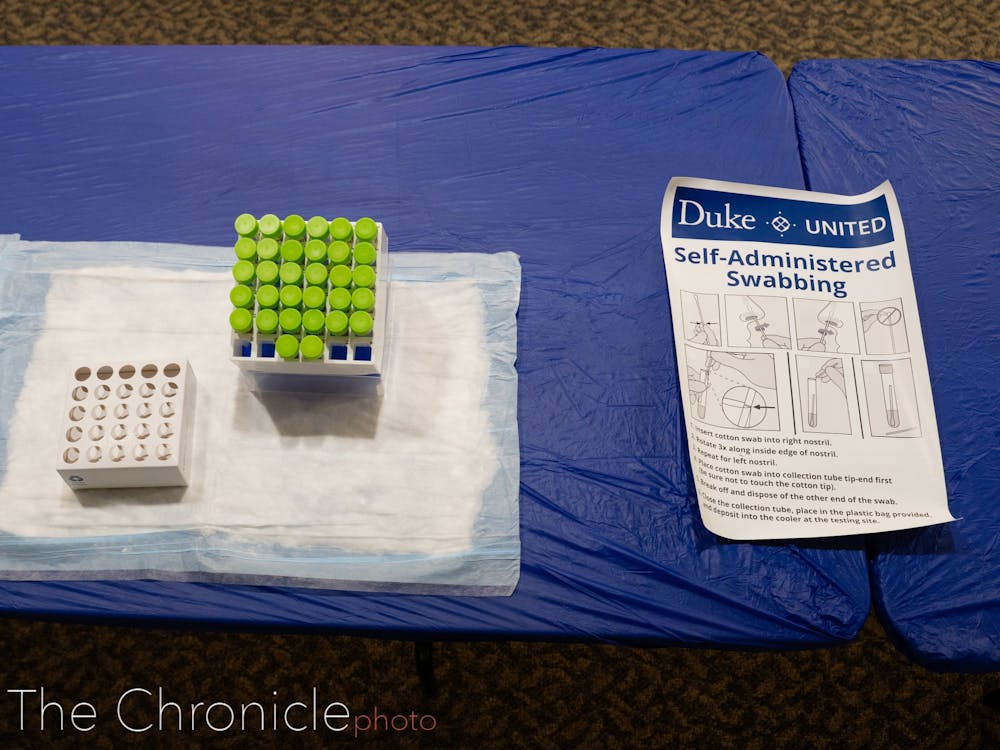Colleges’ decisions to reopen this fall have raised concerns that outbreaks on campus could lead to COVID-19 spreading in college towns.
However, a recent geospatial analysis by researchers at Duke and the University of North Carolina at Chapel Hill found little evidence that student cases of COVID-19 at a sample of North Carolina universities had spilled over into the wider community.
Aaron McKethan, co-author and senior policy fellow at the Duke-Margolis Center for Health Policy, said that this conclusion was solely based on data provided by the state and that it was not definitive.
“We try not to overstate what we can’t really say other than [in theory], and we’re in the land of theory right now,” McKethan said. He added that researchers try to “embrace a posture of humility” while examining epidemiological phenomena.
The brief, which examines geographic trends of COVID-19 incidence in North Carolina, is the fifth in a series that looks at how the pandemic has affected the state. McKethan, along with Hilary Campbell, research associate at Duke-Margolis, and Mark Holmes, director of the Cecil G. Sheps Center for Health Services Research at UNC, conducted the analysis.
The researchers expected to see a rapid increase in cases among 18 to 22-year-olds living near major universities, followed by a later increase in cases among older age groups in the same area.
Sure enough, in mid-August there was a notable spike in cases among college-aged individuals around Greenville—where East Carolina University is located—Wilmington—where the University of North Carolina at Wilmington is located—and the Research Triangle. Yet when the researchers examined data from ZIP codes adjacent to major universities, there was “no obvious increase” in cases among other age groups beyond previously established patterns.
“A couple of explanations could possibly be that students don’t come into close contact with faculty and staff as much as they could, so that kind of isolates the outbreak to students,” Campbell said. “It also could be that faculty live in a more dispersed area than the students.”
One limitation of the analysis was that it was unclear whether students reported their home ZIP code or the ZIP code of the address they used at school. The brief also mentions that the analyses performed with the state-provided numbers yielded total case counts lower than those reported by the universities themselves, indicating challenges in associating cases with specific institutions.
In addition to studying universities, the team looked into which age groups and areas are presently most impacted by COVID-19.
Adults over the age of 80 continue to have one of the highest rates of new cases per capita, while young children and adults between 60 and 80 years old had the lowest incidence rates per capita.
There were also increases in cases among adults in the 20-30 age range in late spring and summer, according to the brief. Aside from Fayetteville and Greenville, which had similar rates across age groups, the highest case rates were typically seen in young adults.
Although viral transmission was initially concentrated in urban areas, it has now shifted to more rural areas. McKethan said that the pandemic at its core was “a very simple phenomenon” in terms of infection, but when it comes to populations, it’s more dynamic.
“If you think about it from a global or population standpoint, it started out as a very metro-focused pandemic focusing on people that are older, the most vulnerable and other special populations like prisons. It then evolved to the rural areas and the younger demographic, and that shifted the focus from the ratio of reported cases to hospitalizations,” McKethan said.
The decrease in hospitalizations as younger people became infected more often was “stage two.” Stage three, McKethan said, is broad spread in rural and metropolitan areas with increased variation by region.
Campbell said the trends of infection in North Carolina mirror what’s happening nationwide.
“It started in more urban, states and it took awhile for there to be enough contacts with more people in rural areas, and now that it’s there it’s really spreading,” she said.
Although the impact of reopening universities on viral spread is not yet fully clear, McKethan and Campbell agreed that institutions could play important roles in their communities as the pandemic continues.
“I think number one, really, is being the eyes and ears of the community about what the resource gaps are,” McKethan said. “It’s just hard, when you’re in Raleigh, to fully appreciate that there is tremendous variation in the kind of resources that don’t always manifest in the ways you might expect.”
McKethan cited workplace conditions at a chicken plant as an example, saying that although working conditions could be improved, “what we can’t always understand when we’re looking at things through a data lens in the center part of the state is what happens when that plant hits closing time”. Universities can help appreciate nuances about “how people live in the real world,” he said.
Devoting academic resources to understanding communities is also important, Campbell said.
“Staying connected to their communities and studying what’s important to them and what factors shaped them is what makes you prepared for unexpected situations like this, instead of starting from scratch,” Campbell said.
Get The Chronicle straight to your inbox
Signup for our weekly newsletter. Cancel at any time.

Nadia Bey, Trinity '23, was managing editor for The Chronicle's 117th volume and digital strategy director for Volume 118.

